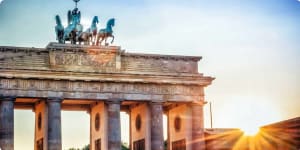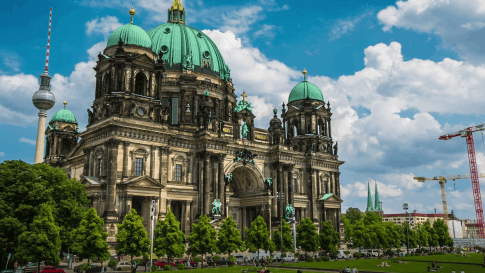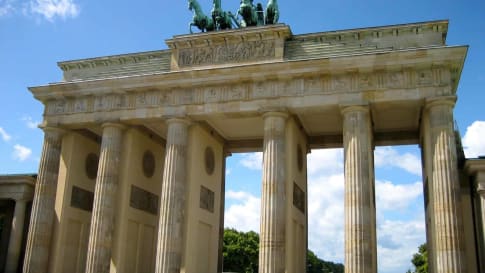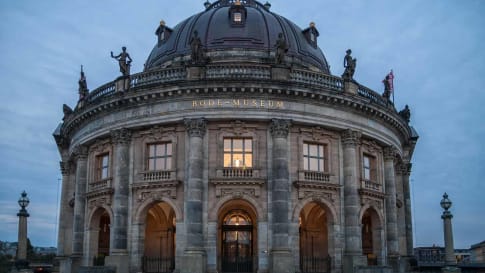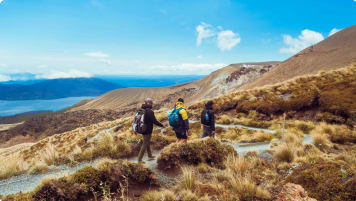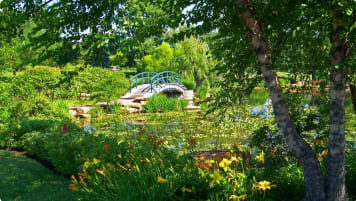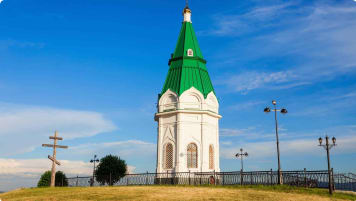Berlin walking tour
Enjoy an escorted walking tour of Berlin. This small group holiday is for like minded people, mature couples or solo travelers who enjoy getting off the beaten track and exploring with some adventure. The itineraries set for each day follow sections of the Berlin Wall, whilst local guides realise authentic experiences found in this amazing city.
From A$9,195AUD

Highlights
- 1. Learn about Berlin's history with visits to museums and monuments
- 2. Experience Sansoucci, the summer Palace of Prussian Kings
- 3. Escape from the city’s pace at Eiskeller in the stunning Spandauer Forest
- 4. Enjoy a performance by world-renowned Berliner Philharmonica
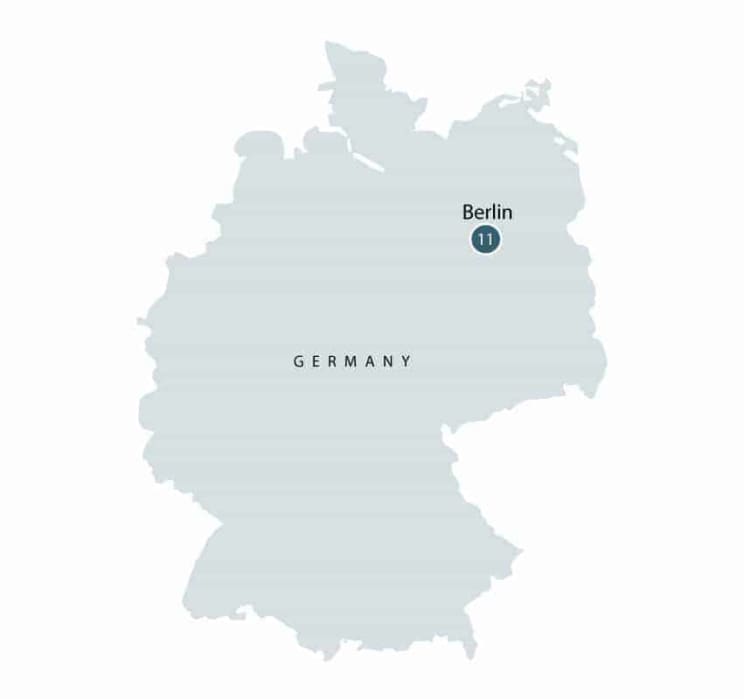
Departure Dates
| Departure Date | Price |
|---|---|
| 06 October 2025 Ends 17 October 2025 • 12 days A$9,195 Twin A$10,795 Single Available | Selected |
| 04 May 2026 Ends 15 May 2026 • 12 days A$10,250 Twin A$11,995 Single Available | |
| 05 October 2026 Ends 16 October 2026 • 12 days A$10,250 Twin A$11,995 Single Available | |
| 03 May 2027 Ends 14 May 2027 • 12 days A$10,750 Twin A$12,250 Single Available | |
| 04 October 2027 Ends 15 October 2027 • 12 days A$10,750 Twin A$12,250 Single Available |
Berlin Walking Tour: 12 days of exploring the city
During this Berlin Walking Tour we'll explore the rich history of the city on foot. At every turn are traces of a past plagued by conflict, and stories of powerful resistance. The Berlin Wall stood in place from 1961 to 1989, separating Germany , East from West. But after its collapse, the city transformed, and an influx of creativity and vibrancy is palpable wherever you go.
This 12 day walking tour explores the history of the Berlin using the Wall as a reference point. As we track its path, we stop in at checkpoints and memorial sites throughout this Berlin tour: for famous crossings, and for tragic events. We will learn about the Cold War and the events of World War II, but we will also experience Berlin's beauty and culture in the present day.
Exploring the city of Berlin on foot gives us a local's perspective, meaning we see what tourists miss. Our Berlin city touruses the "wall" as a way to experience the diversity and spectacular sights of modern Berlin. Berlin is home to great rivers including the Spree river and majestic forests, and stunning architecture from the Rococo to the Modern and contemporary. We even get to experience some 18th century history, wandering amongst the summer palaces of Prussian Kings.
Each day we start the day's walk at a different location in Berlin, from which we explore on foot. The days themes as you walk range from looking at the Berlin city as the German capital or alternative Berlin as we explore street art and museumisland with your tour guide Your days are accompanied by a local tour guide with expertise on the history of Berlin, guiding you to some of the spectacualr sights that contribute to Berlin's history .
Finally, at the end of the day, we return to the comfort of our apartments, living as a Berliner would.
Highlights of our Berlin Walking Tour
Highlights of this tour include learning about Berlin's history. We do this through visits to museums and memorials. And we see a section of the Wall that has been transformed into the world's longest open-air gallery, covered in street art that expresses the experiences of Berliners during the long period in which their city was divided into West and East Berlin.
We tap into Berlin's art scene with visits to a contemporary art gallery housed in a former train station. And we enjoy the city's culture in its more traditional forms, with performances of ballet or opera, and the world-renowned Berliner Philharmonica.
For this 12 day walking tour the group is based in serviced apartments in central Berlin. Each day we have a local historian join us to guide us for the day walks which typically last for 3 to 5 hours plus a break for lunch. This small group tour uses the Berlin public transport network to move around the city to start each day.
Our tour of Berlin also gives you plenty of time to explore for yourself. First time visitors can take in the classic sights of Berlin: the tree-lined Unter den Linden, leading up to the Brandenburg Gate, and the Reichstag Building, the 1933 burning of which was used by Hitler to justify the establishment of a dictatorship. More experienced tourists can get off the beaten path on a self-guided tour in an ever-moving and always rewarding city.
We also take a guided walking tour of Potsdam, a UNESCO World Heritage Site, on a day trip, where we see the grand 19th century Villa Schoningen and Sanssouci Palace, the Rococo summer palace of Frederick the Great.
We created a list of recommended books about Berlin. for those visiting Berlin! You can also explore our country profile about Germany where you'll find all other Odyssey tours departing to the country.
For more details, click the ‘Top 5’ or ‘Itinerary’ buttons above! If you’re keen to experience this tour, please call or send an email. Or, to book, simply fill in the form on the right hand side of this page.
Enjoy Odyssey's long stay tours to explore city programs
Since 2012 Odyssey has offered long stay tours based in some of the greatest cities of the world. It began with exploring French history by rail inspired by Ina Caro's book.
Since that first long stay city tour Odyssey had added the following great cities to the list:
- Rome
- Barcelona
- Paris
- Florence
- Discovering Berlin
- History of France by rail
- Contemporary Japan
- Lisbon & Barcelona
These programs are centred in cities where you have indicated that you would like to return to explore further. They are places of cultural and historic importance where in a different life or different time you would have enjoyed a period of living in these cities. So whilst you may not be able to live here today, you can spend 3 weeks living as a local exploring with a local guide all that each city has to offer. A chance to return to explore some of the greatest and truly fascinating cities of the world.
About seniors walking tours from Odyssey Traveller
Odyssey Traveller offers a range of walking tours each year paced for senior travellers. The collection of walks are for active mature and senior travellers, particularly those who seek out walking tours that are typically off the main circuit. We also published articles to help senior travellers prepare for such tours:
- articles on Selecting walking shoes for women
- article on footwear and walking shoes
- article on what to pack when travelling.
- article on maintaining muscle fitness in senior and mature age travellers
- article on selecting socks for walking
- article on preparing for a walking holiday
- article on Pilgrim walks in Europe
Articles about Berlin, Germany and published by Odyssey Traveller
The following list of articles published by odyssey Traveller for mature aged and senior travellers to maximise their knowledge and enjoyment of Berlin and Germany when visiting;
- A history of Berlin for Tourists.
- A guide to Germany
- Fifteen must see sights in Berlin
- A list of ten books for people thinking of visiting Berlin
- Ten of the Best art galleries in Europe to visit.
- The Bauhaus School
External articles to assist you on your visit to Berlin
Gallery

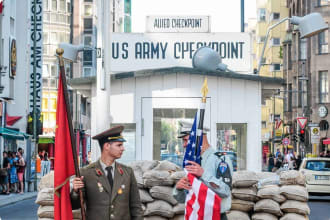

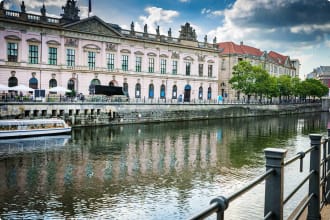

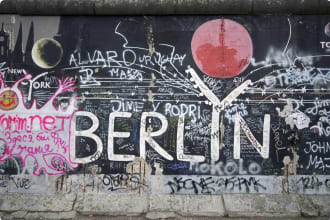
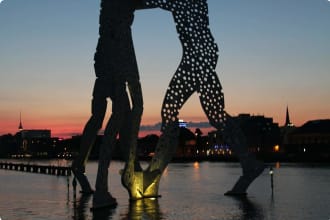

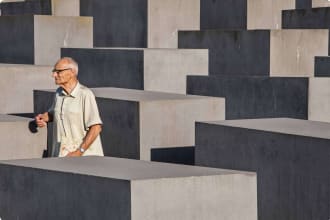
Itinerary
12 days
Day 1: Berlin
Accommodation: Schoenhouse Apartments or similar
We meet at the hotel for tour orientation, followed by a three –course welcome dinner.
Day 2: Lubars to Schonhulz
Accommodation: Schoenhouse Apartments or similar
Today, we take an introductory, 9km walk along the Berlin Wall. We begin at Lubars and head to Schonhulz. Along the way, we visit the Checkpoint Qualitz, which is the memorial tablet for the border opening in 1989. We see Blankenfelde Krankensammellager – the collection camp for sick workers. We visit the Soviet War Museum, which houses the biggest Soviet cemetery in Berlin. It is also the biggest Russian cemetery in Europe, outside of Russia. Finally, we pay our respects at the Memorial Cross for the Berlin Wall victims, who died at this site during the Cold War.
In the evening, we attend a performance of the ballet or opera, pending programming.
Day 3: Wollankstrasse to Nordbahnhof
Accommodation: Schoenhouse Apartments or similar
Wollankstrasse metro station was located in East Berlin, but only people from West Berlin were permitted to use it. Today, we visit the station as we continue our walking tour from Wollankstrasse to Nordbahnhof. We walk along the stunning “Cherry tree alley”, which features trees donated to Berlin in 1990 for the reunification effort. If we are lucky, we might catch them in full bloom! We check out the Bornholmer Straße border crossing, which was the first to be opened during the fall of the Berlin Wall on the 9th of November, 1989.
Next, we visit the Berliner Mauerpark (The Wall Park) in Berlin’s Prenzlauer Berg district. It is located on part of the former heavily-guarded “death strip” or “no man’s land” between the two parallel concrete walls that formed the Berlin Wall. A 300-metre-long section of the inner wall has been preserved as a monument. Today, it’s an an example of very attractive graffiti! The wall was unusually high at this point because of the many visitors to the neighbouring stadium, home of the East Berlin football team, Dynamo Berlin.
After the collapse of the wall in 1989, the former “death strip” was turned into a large, green open space. Today it is one of the most popular parks in Berlin, featuring a regular flea market, live music and various public events.
Later, we visit Berlin documentation centre. Its exhibition, covering 420 square meters, is dedicated to the history of Berlin’s division. Then, we explore the Chapel of reconciliation. Located on the grounds of the former border strip, it was erected at the very site where the Reconciliation Church once stood. After the Wall was built in 1961, the Protestant Church of the Reconciliation Parish was situated within the death strip, and so, was inaccessible. It became a disturbing symbol of the division of Germany and Europe. In 1985, the East German government gave the order for the church to be blown up. After German reunification, the church property was returned to the Reconciliation Parish with the condition that it be used for religious purposes.
Dinner will be provided tonight.
Day 4: Mitte to Lichtenberg
Accommodation: Schoenhouse Apartments or similar
Subject to availability, this morning we will visit Gesundbrunnen station, a former WWII bunker. We will visit the former Stasi prison known since 1994 as the Hohenschönhausen Memorial. It is situated in the former Ministry for State Security’s “Untersuchungshaftanstalt”, which used to be the main remand prison for citizens under investigation. The reality of life under the Stasi – GDR’s secret police – was revealed to the world with the 2007 Oscar winning film “The Lives of Others”.
The remainder of your day is free to explore the city at your leisure.
Day 5: Nordbahnhof to Potsdamer Platz
Accommodation: Schoenhouse Apartments or similar
The day will commence with an exhibition on border and ghost stations at Nordbahnhof. On our 7km walk from Nordbahnhof to Potsdamer Platz, we will pass along Gartenstrasse and Liesenstrasse to view the border crossings Chausseestrasse and Invaliden. Both were sites of dramatic escape attempts, one in 1963 and the other, not long before the collapse of the Wall in 1989. Then, we will have the opportunity to visit the powerful Holocaust memorial, located in Berlin’s government district.
This afternoon, we change pace by checking out Berlin’s vibrant art scene. An influx of artists post-reunification has meant a twenty-year creativity boom in the capital. This creativity influences everything, from the city’s architecture to its vibrant nightlife. We will check out the collection of Berlin entrepreneur Dr Erick Marx, whose pieces – from Rauschenberg to Warhol – are housed in the Hamburger Bahnhof. A former train station that was built in 1847, the National Gallery also has a permanent collection here of modern and contemporary art.
Dinner is provided tonight.
Day 6: Potsdamer Platz to Warschauer Street
Accommodation: Schoenhouse Apartments or similar
Today, we transfer by bus to Potsdamer Platz. Our walking tour takes us to the Topography of Terror Memorial. A large documentation centre in the heart of Berlin, its focus is the state apparatus responsible for the regime of terror during the Nazi period in Germany and occupied territories. Here, at the former Prinz-Albrecht-Straße 8 was the head office of the Geheime Staatspolizei (Gestapo / Secret Police). The original building was destroyed during the Second World War. Its location on the US-Soviet border meant the site was disused during the Cold War, frequently a dumping ground for rubble. Today, the longest surviving piece of the Berlin Wall is directly next to the site.
Afterwards, we continue our exploration of Berlin’s checkpoints, including Heinrich-Heine-Straße, and the famous Checkpoint Charlie. A white line on the street Friedrichstraße, drawn in the night between September 6 and 7, 1961, marked the border between East and West Berlin. Checkpoint Charlie was the best-known crossing point. We view the famous East-Side Gallery. What was once a section of the Berlin Wall is now the world’s longest open-air gallery, stretching 1.3km, and featuring over one hundred different paintings.
Day 7: Berlin
Accommodation: Schoenhouse Apartments or similar
Today, the day is free for you to explore Berlin at leisure. In the evening, we will attend a performance by the Berliner Philharmonica, which is consistently ranked as one of the best orchestras in the world.
Day 8: Warschauer Street to Schoneweide
Accommodation: Schoenhouse Apartments or similar
Today, our walk takes us from Warschauer Street to Schoneweide. En route, we’ll see the Molecule Men, an aluminium sculpture made by American artist Jonathan Borofsky. Located right in the river, it shows three bodies embracing. It is a symbol of the joining of the three districts of Kreuzberg, Friedrichshain and Treptow across the former watery border. We see the double-deck Oberbaum Bridge crossing Berlin’s River Spree, considered one of the city’s landmarks. We visit the Soviet War Memorial in Berlin’s Treptower Park. It was built to the design of the Soviet architect Yakov Belopolsky to commemorate 7,000 of the 80,000 Soviet soldiers who fell in the Battle of Berlin in April–May 1945. It opened four years after World War II on May 8, 1949. The Memorial served as the central war memorial of East Germany.
We visit the border crossing Sonnenallee: Compared to other checkpoints, the border crossing at Sonnenallee attracted little attention during the years of division – until the film “Sonnenallee,” made after the fall of the Wall. Along the canal, we also visit the memorial stone of Chris Gueffroy, the last person to die trying to escape across the Berlin Wall. We will walk to Hufeisenseidlung before transferring back to our hotel.
Dinner will be provided this evening.
Day 9: Schöneweide to Schönefeld
Accommodation: Schoenhouse Apartments or similar
Today, we visit a Documentation Centre to learn about the history of Nazi forced labour in Berlin-Schöneweide. We head to Hinterland wall – a 28-meter-high artificial hill created by the rubble of buildings destroyed in the war. It was used as a garbage dump until 1958. Remains of the Hinterland wall (inner wall) can still be seen at their original location.
We will learn about the Berlin spy tunnel near Rudower Hohe. And we visit the checkpoint at Waltersdorf Chaussee/Rudow Chaussee, which, in addition to transporting people to and from the Berlin-Schönefeld airport, was also opened for passage of West Berliners into the German Democratic Republic.
Day 10: Gropiusstadt to Pottsdam
Accommodation: Schoenhouse Apartments or similar
Today, we take a day excursion along the Southern route of the Berlin Wall. Along the way, we’ll see the Modernist high-rise architecture of Gropiusstadt, a district in Neukölln.
We visit Checkpoint Bravo (“Checkpoint B”), and then Klein Glienicke – a village in the border district. During the period of the partition, Klein-Glienicke was, in effect, an exclave, a “special security zone” of the GDR. Since 1990, parts of the village have been protected as UNESCO World Heritage sites.
Next, we will see the Glienicke Bridge across Germany’s Havel River. During the Cold War, as this portion of the Havel River formed the border between West Berlin and East Germany, the bridge was used several times for the exchange of captured spies and thus became known as the Bridge of Spies. Events here inspired the 2015 Hollywood thriller of the same name.
We will also visit nearby Villa Schoningen. On behalf of the Prussian King Frederick William IV, in 1843, Ludwig Persius designed this house in the Italian Villa style for Kurd von Schöning, the chamberlain of Prince Carl of Prussia. Now a museum, it houses permanent, and visiting, collections of art and artefacts. A segment of the Berlin Wall in front of the Villa is part of the Berlin-Potsdam’s UNESCO World Heritage site. A classic English park is a short walk away, as is Pfaueninsel (Peacock Island). This was the summer residence of the Prussian Kings. We will catch a short ferry across to marvel at its preserved grandeur, juxtaposed with the island’s rustic working farm.
Finally, while in Pottsdam, we will visit Sanssouci, summer palace of the King of Prussia, Frederick the Great. Thought to rival Versailles, this Roccoco-style palace is smaller than its French Baroque counterpart, but just as impressive.
Dinner is provided tonight.
Day 11: Wannsee to Eiskellar
Accommodation: Schoenhouse Apartments or similar
Today, we venture along the Western route of the Berlin Wall. We transfer, by bus, to Wannsee, before taking a ferry to Kladow. On arrival, we walk to Sacrow to visit the Church of the Redeemer (Heilandskirche). Located at the border, the barrier was built straight across the lot of the church property and the bell tower was used as part of the protective wall of concrete.
Next, we walk to Staaken, stopping off to view a former border train station. We then transfer to Spandauer Forst for a walk to Eiskeller. The beautiful Eiskeller is named for “ice cellar”; it’s considered to be Berlin’s coldest spot during winter. During the division, it was a West Berlin exclave, surrounded on all sides by the Wall. Today, Spandauer Forst is a peaceful escape from the bustle of the city, home to rare plants and animals including kingfishers, hawks and beavers.
Tonight, we have dinner in a local restaurant for our final night of the tour.
Day 12: Berlin
Our tour concludes after breakfast.
Tour Notes
- Small group walking tour Limited to 12 people
Includes / Excludes
What’s included in our Tour
- 11 nights of hotel accommodation.
- 11 breakfasts and 6 dinners.
- Applicable entry fees and services of local guides.
- Service charges and gratuities.
- Touring by comfortable and modern coach or public transport.
- Transport and field trips as indicated.
- Services of a Tour Leader.
- Detailed tour information booklet.
What’s not included in our Tour
- Return international airfares and departure taxes.
- Comprehensive travel insurance.
Participants must be able to carry their own luggage, climb and descend stairs, be in good health, mobile and able to participate in 3-5 hours of physical activity per day, the equivalent of walking / hiking up to 8 kilometers per day on uneven ground.
Book now
Make it a private tour
Easing your journey
Crossing international borders with restrictions
The list of requirements to travel internationally has changed and will continue to change for several years. Odyssey is here to assist you in managing your way through these requirements:
For more information see our Crossing international borders with restrictions page.
Book With Confidence
If less than 30 days before your tour starts you are unable to travel as a result of Government travel restrictions, Odyssey Traveller will assist you with a date change, provide you with a credit or process a refund for your booking less any non-recoverable costs.
See Terms and conditions for details.
Peace of Mind Travel
The safety of our travellers, tour leader, local guide and support staff has always been our top priority and with the new guidelines for public health and safety for keeping safe for destinations around the world, we’ve developed our plan to give you peace of mind when travelling with us.
See Peace of Mind Travel for details.
Reading List Download PDF
Berlin: Portrait of a City Through the Centuries
Rory MacLean
Berlin is a city of fragments and ghosts, a laboratory of ideas, the fount of both the brightest and darkest designs of history's most bloody century. The once arrogant capital of Europe was devastated by Allied bombs, divided by the Wall, then reunited and reborn as one of the creative centers of the world. Today it resonates with the echo of lives lived. No other city has repeatedly been so powerful and fallen so low; few other cities have been so shaped and defined by individual imaginations.
Berlin tells the volatile history of Europe's capital over five centuries through a series of intimate portraits of two dozen key residents: the medieval balladeer whose suffering explains the Nazis' rise to power; the genius Jewish chemist who invented poison gas for First World War battlefields and then the death camps; the iconic mythmakers like Christopher Isherwood, Leni Riefenstahl, and David Bowie, whose heated visions are now as real as the city's bricks and mortar. Alongside are portrayed some of the countless ordinary Berliners whose lives can only be imagined: the ambitious prostitute who refashioned herself as a baroness, the fearful Communist Party functionary who helped to build the Wall, and the American spy from the Midwest whose patriotism may have turned the course of the Cold War.
Berlin is a history book like no other, with an originality that reflects the nature of the city itself. In its architecture, through its literature, in its movies and songs, Berliners have conjured their hard capital into a place of fantastic human fantasy. No other city has so often surrendered itself to its own seductive myths. Berlin captures, portrays, and propagates the remarkable story of those myths and their makers.
A Woman in Berlin: Eight Weeks in the Conquered City: A Diary
Anonymous
For eight weeks in 1945, as Berlin fell to the Russian army, a young woman kept a daily record of life in her apartment building and among its residents. "With bald honesty and brutal lyricism" (Elle), the anonymous author depicts her fellow Berliners in all their humanity, as well as their cravenness, corrupted first by hunger and then by the Russians. "Spare and unpredictable, minutely observed and utterly free of self-pity" (The Plain Dealer, Cleveland), A Woman in Berlin tells of the complex relationship between civilians and an occupying army and the shameful indignities to which women in a conquered city are always subject--the mass rape suffered by all, regardless of age or infirmity.
A Woman in Berlin stands as "one of the essential books for understanding war and life" (A. S. Byatt, author of Possession).
The Fall of Berlin 1945
Antony Beevor
The Red Army had much to avenge when it finally reached the frontiers of the Third Reich in January 1945. Frenzied by their terrible experiences with Wehrmacht and SS brutality, they wreaked havoc—tanks crushing refugee columns, mass rape, pillage, and unimaginable destruction. Hundreds of thousands of women are children froze to death or were massacred; more than seven million fled westward from the fury of the Red Army. It was the most terrifying example of fire and sword ever known.
Antony Beevor has reconstructed the experiences of those millions caught up in the nightmare of the Third Reich's final collapse. The Fall of Berlin is a terrible story of pride, stupidity, fanaticism, revenge, and savagery, yet it is also one of astonishing endurance, self-sacrifice, and survival against all odds.
Berlin Game (Samson)
Len Deighton
Long-awaited reissue of the first part of the classic spy trilogy, GAME, SET and MATCH, when the Berlin Wall divided not just a city but a world.
East is East and West is West – and they meet in Berlin…
He was the best source the Department ever had, but now he desperately wanted to come over the Wall. ‘Brahms Four’ was certain a high-ranking mole was set to betray him. There was only one Englishman he trusted any more: someone from the old days.
So they decided to put Bernard Samson back into the field after five sedentary years of flying a desk.
The field is Berlin.
The game is as baffling, treacherous and lethal as ever…
Berlin Calling: A Story of Anarchy, Music, The Wall, and the Birth of the New Berlin
Paul Hockenos
Berlin Calling is a gripping account of the 1989 "peaceful revolution" in East Germany that upended communism and the tumultuous years of artistic ferment, political improvisation, and pirate utopias that followed. It’s the story of a newly undivided Berlin when protest and punk rock, bohemia and direct democracy, techno and free theater were the order of the day.
In a story stocked with fascinating characters from Berlin’s highly politicized undergrounds—including playwright Heiner Müller, cult figure Blixa Bargeld of the industrial band Einstürzende Neubauten, the internationally known French Wall artist Thierry Noir, the American multimedia artist Danielle de Picciotto (founder of Love Parade), and David Bowie during his Ziggy Stardust incarnation—Hockenos argues that the DIY energy and raw urban vibe of the early 1990s shaped the new Berlin and still pulses through the city today.
Just as Mike Davis captured Los Angeles in his City of Quartz, Berlin Calling is a unique account of how Berlin became hip, and of why it continues to attract creative types from the world over.
The Reader
Bernhard Schlink
Hailed for its coiled eroticism and the moral claims it makes upon the reader, this mesmerizing novel is a story of love and secrets, horror and compassion, unfolding against the haunted landscape of postwar Germany.
When he falls ill on his way home from school, fifteen-year-old Michael Berg is rescued by Hanna, a woman twice his age. In time she becomes his lover—then she inexplicably disappears. When Michael next sees her, he is a young law student, and she is on trial for a hideous crime. As he watches her refuse to defend her innocence, Michael gradually realizes that Hanna may be guarding a secret she considers more shameful than murder.
Stasiland
Anna Funder
“Stasiland demonstrates that great, original reporting is still possible. . . . A heartbreaking, beautifully written book. A classic.” —Claire Tomalin, Guardian “Books of the Year”
Anna Funder delivers a prize-winning and powerfully rendered account of the resistance against East Germany’s communist dictatorship in these harrowing,personal tales of life behind the Iron Curtain—and, especially, of life under the iron fist of the Stasi, East Germany’s brutal state security force. In the tradition of Frederick Taylor’s The Berlin Wall and Philip Gourevitch’s We Wish to Inform You That Tomorrow We Will be Killed With Our Families, Funder’s Stasiland is a masterpiece of investigative reporting, written with novelistic vividness and the compelling intensity of a universal, real-life story.
The Berlin Stories
Christopher Isherwood
A classic of 20th-century fiction, The Berlin Stories inspired the Broadway musical and Oscar-winning film Cabaret.
First published in the 1930s, The Berlin Stories contains two astonishing related novels, The Last of Mr. Norris and Goodbye to Berlin, which are recognized today as classics of modern fiction. Isherwood magnificently captures 1931 Berlin: charming, with its avenues and cafés; marvelously grotesque, with its nightlife and dreamers; dangerous, with its vice and intrigue; powerful and seedy, with its mobs and millionaires―this is the period when Hitler was beginning his move to power. The Berlin Stories is inhabited by a wealth of characters: the unforgettable Sally Bowles, whose misadventures in the demimonde were popularized on the American stage and screen by Julie Harris in I Am A Camera and Liza Minnelli in Cabaret; Mr. Norris, the improbable old debauchee mysteriously caught between the Nazis and the Communists; plump Fräulein Schroeder, who thinks an operation to reduce the scale of her Büste might relieve her heart palpitations; and the distinguished and doomed Jewish family, the Landauers.
Every Man Dies Alone
Hans Fallada
A New York Times Book Review Notable Book of the Year
“The greatest book ever written about the German resistance to the Nazis.” —Primo Levi
“One of the most extraordinary and compelling novels ever written about World War II. Ever. ... Please, do not miss this.” —Alan Furst
"It has something of the horror of Conrad, the madness of Dostoyevsky and the chilling menace of Capote’s In Cold Blood.... In the quiet Quangels, Fallada has created an immortal symbol of those who fight back against 'the vile beyond all vileness' and so redeem us all." —Roger Cohen, The New York Times
“An unrivalled and vivid portrait of life in wartime Berlin.” —Philip Kerr, author of the "Berlin Noir" novels
“Has the suspense of a John le Carré novel … visceral, chilling ….” —The New Yorker
“One of the most extraordinarily ambitious literary resurrections in recent memory ....” —The Los Angeles Times
“A one-of-a-kind novel … Fallada can be seen as a hero, a writer-hero who survived just long enough to strike back at his oppressors.” —The Globe and Mail
“Stunningly vivid characters … gets you inside Nazi Germany like no other novel.” —The San Francisco Chronicle
“Essential, thrilling.” —The St. Petersburg Times
“This is a novel that is so powerful, so intense, that it almost hums with electricity." —Minneapolis Star-Tribune
The Innocent
Ian McEwan
A member of a British-American surveillance team in Cold War Berlin finds himself in too deep in this masterful work from the author of Atonement. Twenty-five-year-old Leonard Marnham’s intelligence work—tunneling under a Russian communications center to tap the phone lines to Moscow—offers him a welcome opportunity to begin shedding his own unwanted innocence, even if he is only a bit player in a grim international comedy of errors. His relationship with Maria Eckdorf, an enigmatic and beautiful West Berliner, likewise promises to loosen the bonds of his ordinary life. But the promise turns to horror in the course of one terrible evening—a night when Marnham learns just how much of his innocence he's willing to shed.
The Ghosts of Berlin: Confronting German History in the Urban Landscape
Brian Ladd
In this compelling work, Brian Ladd examines the ongoing conflicts radiating from the remarkable fusion of architecture, history, and national identity in Berlin. Ladd surveys the urban landscape, excavating its ruins, contemplating its buildings and memorials, and carefully deconstructing the public debates and political controversies emerging from its past.
"Written in a clear and elegant style, The Ghosts of Berlin is not just another colorless architectural history of the German capital. . . . Mr. Ladd's book is a superb guide to this process of urban self-definition, both past and present."—Katharina Thote, Wall Street Journal
"If a book can have the power to change a public debate, then The Ghosts of Berlin is such a book. Among the many new books about Berlin that I have read, Brian Ladd's is certainly the most impressive. . . . Ladd's approach also owes its success to the fact that he is a good storyteller. His history of Berlin's architectural successes and failures reads entertainingly like a detective novel."—Peter Schneider, New Republic
"[Ladd's] well-written and well-illustrated book amounts to a brief history of the city as well as a guide to its landscape."—Anthony Grafton, New York Review of Books
The Berlin Wall: The History and Legacy of the World's Most Notorious Wall
Charles Rivers
“From Stettin in the Baltic to Trieste in the Adriatic an ‘Iron Curtain’ has descended across the continent. Behind that line lie all the capitals of the ancient states of Central and Eastern Europe. Warsaw, Berlin, Prague, Vienna, Budapest, Belgrade, Bucharest and Sofia; all these famous cities and the populations around them lie in what I must call the Soviet sphere, and all are subject, in one form or another, not only to Soviet influence but to a very high and in some cases increasing measure of control from Moscow.” – Winston Churchill, 1946
"This is a historic day. East Germany has announced that, starting immediately, its borders are open to everyone. The GDR is opening its borders ... the gates in the Berlin Wall stand open." – German anchorman Hans Joachim Friedrichs
Though it never got “hot,” the Cold War was a tense era until the dissolution of the USSR, and nothing symbolized the split more than the Berlin Wall, which literally divided the city. Berlin had been a flashpoint even before World War II ended, and the city was occupied by the different Allies even as the close of the war turned them into adversaries. After the Soviets’ blockade of West Berlin was prevented by the Berlin Airlift, the Eastern Bloc and the Western powers continued to control different sections of the city, and by the 1960s, East Germany was pushing for a solution to the problem of an enclave of freedom within its borders. West Berlin was a haven for highly-educated East Germans who wanted freedom and a better life in the West, and this “brain drain” was threatening the survival of the East German economy.
In order to stop this, access to the West through West Berlin had to be cut off, so in August 1961, Soviet premier Nikita Khrushchev authorized East German leader Walter Ulbricht to begin construction of what would become known as the Berlin Wall. The wall, begun on Sunday August 13, would eventually surround the city, in spite of global condemnation, and the Berlin Wall itself would become the symbol for Communist repression in the Eastern Bloc. It also ended Khrushchev’s attempts to conclude a peace treaty among the Four Powers (the Soviets, the Americans, the United Kingdom, and France) and the two German states. The wall would serve as a perfect photo-opportunity for two presidents (Kennedy and Reagan) to hammer the Soviet Communists and their repression, but the Berlin Wall would stand for nearly 30 years, isolating the East from the West. It is estimated about 200 people would die trying to cross the wall to defect to the West.
Things came to a head in 1989. With rapid change throughout Europe, the wall faced a challenge it could not contain, the challenge of democracy’s spread. On the night of November 9, 1989, the Berlin Wall was effectively removed from the midst of the city it so long divided ─removed with pick axes and sledgehammers, but also removed from the hearts and minds of the people on both sides who only hours before had thought the wall’s existence insurmountable. As one writer put it, “No border guard, no wall, can forever shield repressive regimes from the power of subversive ideas, from the lure of freedom.”
The fall of the Berlin Wall is often considered the end of the Cold War, and the following month both President Bush and Gorbachev declared the Cold War over, but the Cold War had been thawing for most of the 1980s. President Reagan is remembered for calling the Soviet Union an “evil empire” and demanding that Gorbachev tear down the wall, but he spent the last several years of his presidency working with the Soviet leader to improve relations. The end of the Soviet Union came when Gorbachev resigned on December 25, 1991. The Soviet Union formally dissolved the next day.
